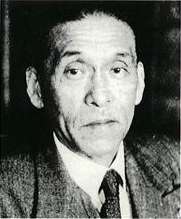Hitoshi Ashida
| Hitoshi Ashida | |
|---|---|
| 芦田 均 | |
 | |
| Prime Minister of Japan | |
|
In office 10 March 1948 – 15 October 1948 | |
| Monarch | Shōwa |
| Governor | Douglas MacArthur |
| Preceded by | Tetsu Katayama |
| Succeeded by | Shigeru Yoshida |
| Personal details | |
| Born |
15 November 1887 Fukuchiyama, Japan |
| Died |
20 June 1959 (aged 71) Tokyo, Japan |
| Political party | Liberal Democratic Party (1955–1959) |
| Other political affiliations |
Constitutional Association of Political Friendship (Before 1945) Liberal Party (1945–1947) Democratic Party (1947–1950) People's Democratic Party (1950–1952) Kaishinto(Reformative Progressive Party) (1952–1954) Japan Democratic Party (1954–1955) |
| Alma mater | Tokyo Imperial University |
| Signature |
 |

Hitoshi Ashida (芦田 均 Ashida Hitoshi, 15 November 1887 – 20 June 1959) was a Japanese politician who served as the 47th Prime Minister of Japan from 10 March to 15 October 1948. He was a prominent figure in the immediate postwar political landscape, but was forced to resign his leadership responsibilities after a corruption scandal (Shōwa Denkō Jiken) targeting two of his cabinet ministers.
Early political life
Ashida was born in Fukuchiyama, Kyoto and studied French civil law at Tokyo Imperial University. After graduation, he worked in the Ministry of Foreign Affairs for twenty years.
In 1932, Ashida ran his first successful campaign for a seat in the House of Representatives as a member of the Seiyūkai Party. He sided with Ichirō Hatoyama's "orthodox" wing following the Seiyukai's split in 1939.
After the war, Ashida won a seat in the new Diet as a member of the Liberal Party,from which he split to merge with Kijūrō Shidehara's Progressive Party to form the Democratic Party. Ashida was elected president of the new party, and became Minister of Foreign Affairs in 1947 under Socialist prime minister Tetsu Katayama.
He also chaired the Committee on the Bill for Revision of the Imperial Constitution, and served as the chairman of the Kenpō Fukyū Kai, a society created to promote the revised Constitution of Japan, from 1946-1948.[1][2]During his term, he made a key amendment to Article Nine of the planned Japanese Constitution, which enabled the creation of the Japanese Self-Defense Force.[3]
Prime Minister and later life
Ashida became prime minister in 1948, leading a coalition government of Democratic and Socialist members. His tenure ended just seven months after it began. Two of his cabinet ministers were accused of corruption in the Showa Electric scandal, which forced the cabinet to resign.[4]
Ten years later, in 1958, Ashida was cleared of all charges in relation to the incident. He died a year later at the age of seventy-one.
References
- ↑ "Alfred Hussey, Memorandum on Program for Publicizing the new Japanese Constitution, February 5, 1947". Birth of the Japanese Constitution. National Diet Library of Japan. Retrieved 24 May 2013.
- ↑ "The Constitution of Japan (The Official Gazettes, a Special Edition)". World Digital Library. Retrieved 24 May 2013.
- ↑ Fumiko Sasaki (26 July 2012). Nationalism, Political Realism and Democracy in Japan: The thought of Masao Maruyama. Routledge. p. 136. ISBN 978-1-136-31378-3. Retrieved 24 May 2013.
- ↑ Masaru Kōno (1997). Japan's postwar party politics. Princeton University Press. p. 64. ISBN 978-0-691-01596-5. Retrieved 24 May 2013.
External links
 Media related to Hitoshi Ashida at Wikimedia Commons
Media related to Hitoshi Ashida at Wikimedia Commons
| Political offices | ||
|---|---|---|
| Preceded by Shigeru Yoshida |
Minister of Foreign Affairs 1947–1948 |
Succeeded by Shigeru Yoshida |
| Preceded by Tetsu Katayama |
Prime Minister of Japan 1948 | |
| Preceded by Kijūrō Shidehara |
Minister of State: Deputy Prime Minister 1947–1948 |
Succeeded by Suehiro Nishio |
| Preceded by Kenzō Matsumura |
Minister for Health and Welfare 1945–1946 |
Succeeded by Yoshinari Kawai |
| House of Representatives of Japan | ||
| New district | Representative for Kyoto 2nd district 1947–1959 Served alongside: Yoshie Ōishi, Shigesaburō Maeo, many others |
Vacant Title next held by Sen'ichi Tanigaki etc. |
| New district | Representative for Kyoto At-large district 1946–1947 Served alongside: Chōzaburō Mizutani, Fusa Tomita, Isaji Tanaka, Yoshie Ōishi, Takeo Nakano, Katsumi Takeuchi, Hanji Ogawa, Chiyo Kimura, Taminouke Tsujii |
district eliminated |
| Preceded by Takeshi Tsuhara Kunikichi Murakami San'ichirō Mizushima |
Representative for Kyoto 3rd district 1932–1946 Served alongside: Momozō Nagata, San'ichirō Mizushima, Takeshi Tsuhara, Kunikichi Murakami, Keijirō Okada |
district eliminated |
| Party political offices | ||
| New political party | President of the Democratic Party 1947–1948 |
Succeeded by Takeru Inukai |
| Preceded by Nirō Hoshijima |
PARC chairman of the Japan Liberal Party 1946–1947 |
Succeeded by Seiichi Ōmura |